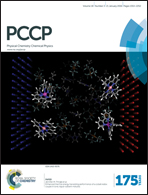Excited-state dynamics of Si–rhodamine and its aggregates: versatile fluorophores for NIR absorption†
Abstract
Since it was first reported in 2008, great attention has been paid to Si–rhodamine (SiR) because of its far-red to near-infrared (NIR) absorption/fluorescence and suitability for high-resolution in vivo imaging. However, properties of SiR in the excited state have not been reported, even though they are directly related to its fluorescence. In the present study, the properties of SiR monomers in the excited states are thoroughly characterized for the first time. Moreover, by replacing a phenyl moiety of SiR with a 4-(9-anthryl)phenylene group (SiR–An), we prepared H- and J-aggregates of SiR in the aqueous solution, and succeeded in monitoring exciton formation and annihilation in the aggregates. Interestingly, the relative exciton population in the SiR J-aggregate increases as the excitation power becomes stronger, which is unusual considering that the substantial exciton–exciton annihilation process occurs as more excitons are generated. The results obtained in the present study suggest high versatility of SiR not only as a red fluorophore in the cutting-edge microscopic techniques but also as a NIR absorber in the light harvesting system.


 Please wait while we load your content...
Please wait while we load your content...